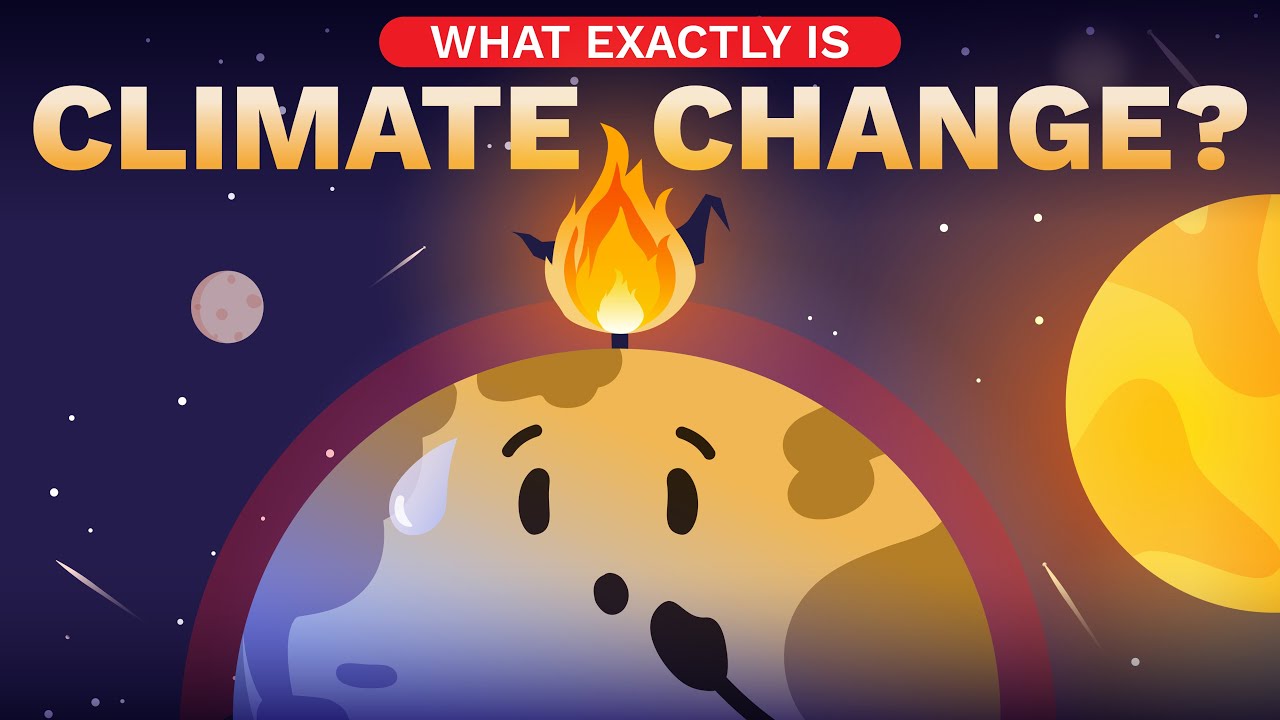The Dire Difference Between 1.5 And 2 Degrees Of Warming - Cheddar News
Summary
TLDRThe video script highlights the critical importance of limiting global warming to 1.5°C above pre-industrial levels, as agreed in the 2015 Paris Agreement. The world has already warmed by 1.1°C, and a further increase of just 0.4°C could trigger drastic consequences, including rising sea levels, deadly heat waves, severe droughts, and mass species loss. At 2°C, these effects intensify. To avoid the worst impacts, global emissions must be reduced by 45% by 2030 and reach zero by 2050. The urgency is clear: swift, decisive action is needed to prevent irreversible damage.
Takeaways
- 🌍 Climate change is often discussed in terms of the temperature rise in degrees Celsius, which is not arbitrary, as every fraction of a degree matters.
- 📅 In 2015, 195 countries signed the Paris Agreement to limit global temperature rise to 1.5°C above pre-industrial levels.
- 🌡️ The Earth is already 1.1°C warmer than it was 150 years ago, and even a 0.4°C increase can have significant impacts on the planet.
- 🌊 At 1.5°C of warming, 69 million people will be directly affected by rising sea levels, but at 2°C, this number increases to 80 million.
- 🔥 With 1.5°C of warming, 14% of the global population will face deadly heat waves at least once every five years, and this rises to 37% at 2°C.
- 💧 An additional 61 million people will be exposed to severe drought at 2°C of warming compared to 1.5°C.
- 🌱 At 2°C of warming, we would lose twice the number of plant and animal species, triple the number of insect species, and 99% of coral reefs.
- ⚡ A 2°C increase would lead to a significant rise in extreme weather events, including storms and floods.
- 📉 The impacts of climate change vary regionally, and some areas of the world will suffer far more than others.
- ⏳ Scientists believe we still have time to avoid the worst consequences of climate change, but urgent action is needed to keep warming below 1.5°C.
- 🚨 To meet the 1.5°C target, global emissions must be reduced by 45% by 2030 and reach zero by 2050—an ambitious but necessary goal.
Q & A
What is the significance of the 1.5°C target in the Paris Agreement?
-The 1.5°C target is crucial because it represents the maximum global temperature increase that signatories to the Paris Agreement aim to limit. Exceeding this threshold could lead to irreversible damage to ecosystems and a higher risk of extreme weather events.
How much has the Earth's temperature already increased compared to pre-industrial levels?
-The Earth's temperature has already increased by 1.1°C compared to pre-industrial levels, meaning that we are already seeing the effects of climate change.
Why does even a small increase in temperature matter?
-Even a 0.1°C increase can have significant consequences, as it can lead to more severe weather patterns, rising sea levels, and increased risks to biodiversity and human populations.
What happens if global temperatures rise by 1.5°C?
-At 1.5°C of warming, 69 million people will be directly affected by rising sea levels, 14% of the world's population will face deadly heat waves at least once every five years, and many regions will suffer severe droughts.
How would a 2°C increase in global temperatures impact the planet?
-At 2°C of warming, sea level rise will affect 80 million people, 37% of the population will experience deadly heat waves, and there will be a significant loss of biodiversity, including doubling the loss of plant and animal species and almost total destruction of coral reefs.
What are the projected effects of a 2°C rise in temperature on plant, animal, and insect species?
-A 2°C rise in temperature is projected to result in the loss of double the number of plant and animal species, triple the number of insect species, and the near-complete disappearance of coral reefs.
How will extreme weather events change with increasing global temperatures?
-As the global temperature increases, the frequency and severity of extreme weather events, such as storms, heatwaves, and floods, will significantly increase, making many regions more vulnerable.
Why are global averages not enough to understand the impact of climate change?
-Global averages mask regional variations, and different parts of the world will experience the effects of climate change differently. Some areas will suffer far worse than others, which requires a localized understanding of the impacts.
Is it too late to reverse the damage caused by climate change?
-While much damage has already been done, scientists agree that it is still possible to minimize the worst impacts if we act swiftly and limit global warming to 1.5°C.
What are the steps required to meet the 1.5°C target set by the Paris Agreement?
-To meet the 1.5°C target, global emissions need to be reduced by 45% by 2030 and reach net-zero emissions by 2050. This requires rapid and substantial global action to reduce greenhouse gas emissions.
Outlines

Этот раздел доступен только подписчикам платных тарифов. Пожалуйста, перейдите на платный тариф для доступа.
Перейти на платный тарифMindmap

Этот раздел доступен только подписчикам платных тарифов. Пожалуйста, перейдите на платный тариф для доступа.
Перейти на платный тарифKeywords

Этот раздел доступен только подписчикам платных тарифов. Пожалуйста, перейдите на платный тариф для доступа.
Перейти на платный тарифHighlights

Этот раздел доступен только подписчикам платных тарифов. Пожалуйста, перейдите на платный тариф для доступа.
Перейти на платный тарифTranscripts

Этот раздел доступен только подписчикам платных тарифов. Пожалуйста, перейдите на платный тариф для доступа.
Перейти на платный тарифПосмотреть больше похожих видео

What happens if the planet warms by 2°C? | WWF

AR6 Synthesis Report: Climate Change 2023

Material on Global Warming Part 2 | Positive and Negative Impacts of Global Warming

Climate Change 2021: The Physical Science Basis - Full video

Repórter Eco | Especial COP26 | 31/10/2021

Climate Change: How does it really work? | ClimateScience #1
5.0 / 5 (0 votes)
